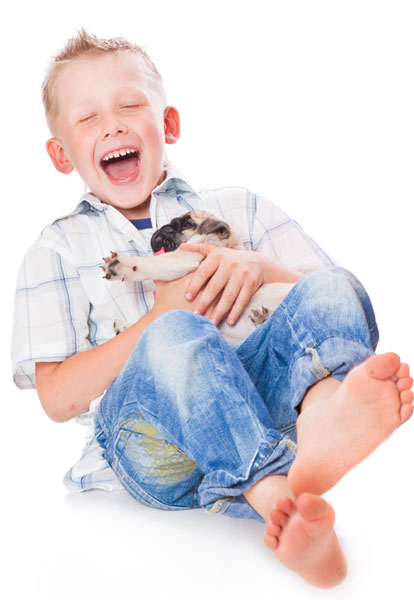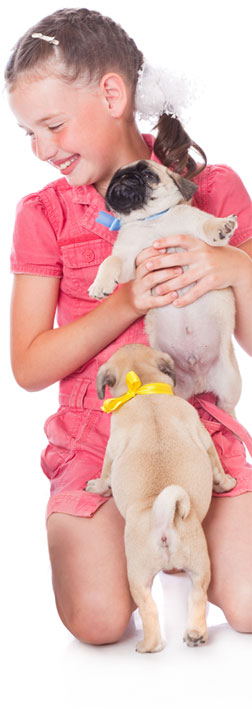If you see this icon in a fact sheet summary you may be dealing with a life threatening issue. Consult a veterinarian immediately.
Use our webform to ask a question or book an appointment

OBESITY
Strictly speaking, obesity is not in itself an ‘illness’ or a disease. You can call it a syndrome; a condition of excess body weight, defined as fat accumulation, where the body weight is 15% or more above the ideal weight, and great enough to cause harm to health or wellbeing. We include it here amongst our disease fact sheets because of the rapidly growing problem of overweight dogs (and cats) in Australia. Dogs and cats are covered here.
In recent years we have seen what can only be described as an explosion in the number of obese cats and dogs coming into Alpine Animal Doctors. Like diabetes, a serious illness in which obesity can be a major causative factor, this increase in the number of ‘fat pets’ we see is mirroring trends in the human population. And for exactly the same reasons. Put simply, too many pet owners are either feeding their pets too much of the wrong foods, and/or failing to provide them with enough healthy exercise.
Obesity may not be an illness itself, but it is a debilitating condition that is linked to a wide range of health issues with serious consequences for you pets. Fortunately it is also very treatable.
SEVERITY: Potentially serious and, in some cases, may be life threatening.
Obesity is caused by three main factors:
Overeating. While cats and dogs can regulate the amount they eat by their energy needs, this ‘natural’ regulator can be overridden if the flavour of the food on offer is very desirable, and food is presented more often or in larger quantities than necessary.
Insufficient exercise. Animals tend to become more sedate as they age, when ill or after neutering. The less the animal exercises, the less calories they burn, and therefore the less calories they should be eating.
Decreased energy requirements. Every animal (including human) has his or her own metabolic rate, which can be influenced by many factors including hormones, climate, reproduction status, and body weight. If an animal’s metabolic rate is decreased by any one of these factors, the body automatically stores the energy it is no longer burning as fat.
Other risk factors include gender, breed, and owner lifestyle but, basically, the root cause of obesity is the unnecessary consumption of more calories than the animal needs.
Obesity has been linked to many adverse effects and serious illnesses in both dogs and cats. Common problems caused or exacerbated by obesity include:
- Diabetes Mellitus (Type I and Type II diabetes).
- Hypertension, or high blood pressure, caused by the excess workload on the heart and lungs.
- Neoplasia. Many recent studies have found the incidence of cancer is dramatically higher in obese patients compared to lean patients.
- Decreased immunity. The body’s ability to fight disease is greatly reduced.
- Hepatic Lipidosis/Fatty Liver. Fatty accumulation in the liver of obese cats that stop eating (e.g., if they are unwell) can cause severe illness and possibly death.
- Osteoarthritis is aggravated by obesity because of the extra weight on the joints.
- Skin infections and matted hair may result from decreased grooming in obese cats.
- Bladder infections can result if excess weight prevents a cat from grooming its hind end.
- Obese cats may suffer from increased rates of feline lower urinary tract disease.
- Obesity may accelerate and exacerbate kidney disease and heart disease. Note that obesity, by itself, usually does not cause heart disease.
- Obese pets may suffer respiratory and breathing problems.
- Obese pets are more likely to suffer complications during anesthesia and surgery.
Just about all of these conditions can be avoided by keeping your pet’s weight at an optimum level. To assess the ideal weight for a dog, run your hands gently down the animal’s sides and spine. Even with a light touch you should be able to feel the rib cage and individual vertebrae, but not see them. There should also be an indentation between the rib cage and the hips — this is the dog’s waist line.
Testing a cat’s bodyweight is slightly different as the fat often hangs around the groin and belly area. The rib and spine test for dogs can sometimes be accurate, although it is important to also check for a ‘pouch’ of fat hanging around the abdomen.
‘Treatment’ for obesity is, happily, not difficult. If your pet is diagnosed with obesity, you simply need to take control of his or her food intake. A balanced diet is essential for good health. But please note that we are not talking about just putting you cat or dog ‘on a diet’ here. Eliminating obesity requires a permanent lifestyle change.
The easiest and most cost efficient way of dieting your pet is with a high quality, balanced, commercial weight control premium pet food. We are happy to advise you on the most appropriate nutrition plan for your pet. You will also need to monitor the entire food intake, which means fewer treats, and only treats of the low calorie or low fat variety. Regular weigh-ins at the hospital are recommended so we can chart the progress and make adjustments if necessary. Maintaining goal weight when reached is simply a matter of adjusting the calorie level slightly and, once again, a balanced weight control diet is best.
Our recommendations for using these commercial preparations is not so we can sell you more pet food. If you can prepare complete, balanced low calorie meals at home, that’s great. But it’s almost impossible for an individual to do that. Achieving balanced nutrient diets to bring an animal back from obesity requires a scientifically formulated diet.
Many people with obese animals tell us that they only feed their pets once a day. Perhaps, but it is not the number of meals each day, or even the quantity of food, the problem lies in the quantity of calories they are given each day. It is better for pets to get two smaller meals a day rather than one large one, as this increases the body’s metabolism, and helps to burn calories.
There’s no getting around it — if your pet is overweight, it must be getting more nutrition than it requires. The body stores only the energy it does not need. In short, there are only two ways to defeat obesity — reduced calorie intake, and higher levels of appropriate exercise, preferably a combination of both.
It is of course more difficult to get a cat to exercise. However, cat parents can encourage increased activity by offering toys that stimulate hunting instincts, and by encouraging the cat to both play and to spend time outdoors. Serving their food in a remote area of the house, or the end of the garden may reduce food intake because of the extra effort required to obtain food, and stimulate activity during the cat’s trips to and from their food bowl.
For both cats and dogs, the benefits of eliminating obesity and getting your pets back to a healthy body weight are so great that a caring owner will remain dedicated to the cause, regardless of the frustrations.
MORE DISEASES OF DOGS
DOGS: ADVICE FOR EMERGENCIES




